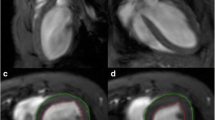Summary
Quantitative magnetic resonance imaging (MRI) was applied to assess structural and functional parameters of the rat heart in vivo. Using ECG and respiratory triggering, MR images were obtained at different time points during the cardiac cycle. This allowed accurate determinations of the left ventricular (LV) mass, wall thickness, LV end-systolic and end-diastolic volumes, stroke volume, and ejection fraction. LV mass determined by MRI showed an excellent linear correlation with post mortem gravimetric determination of LV weight. MRI was then used to examine the pathophysiological changes in two models of LV hypertrophy. In one group of animals the aortic arch was banded to an outer diameter of 1.0 mm to elicit a pressure overload on the LV. A second group was subjected to a volume overload due to graded disruption of the aortic valve. Although both models exhibited a similar degree of LV hypertrophy as shown by the LV weight/body weight ratio, important functional and structural differences were revealed by MRI. Aortic stenosis resulted in an increase in wall thickness, whereas stroke volume and ejection fraction did not differ compared to control animals. In contrast, aortic valve insufficiency did not affect LV wall thickness, however, LV chamber volume as well as stroke volume were markedly increased. Ejection fraction was significantly reduced in these animals. In conclusion, MRI allows the reliable in vivo determination of important structural and functional parameters of hearts in small rodents.
Similar content being viewed by others
References
Alderman DW, Grant DM (1979) An efficient decoupler coil design which reduces heating in conductive samples in superconducting spectrometers. J Magn Reson 36:447–451
Blackband SJ, Chatham J, O'Dell W, Day S (1990) Echo planar imaging of isolated perfused rat hearts at 4.7 T. A comparison of Langendorff and working heart preparations. Magn Reson Med 15:240–245
Gerdes AM, Campbell SE, Hilbelink DR (1988) Structural remodeling of cardiac myocytes in rats with arteriovenous fistulas. Lab Invest 59:857–861
Gülch RW, Jacob R (1988) Geometric and muscle physiologic determinants of cardiac stroke volume as evaluated on the basis of model calculations. Basic Res Cardiol 83:476–485
Higgins CB, Byrd BF, McNamara MT, Lanzer P, Lipton MJ, Botvinik E, Schiller NB, Crooks LE, Kaufman L (1985) Magnetic resonance imaging of the heart: a review of the experience in 172 subjects. Radiology 155:671–679
Jacob R, Gülch RW (1988) Functional significance of ventricular dilatation. Reconsideration of Linzbach's concept of chronic heart failure. Basic Res Cardiol 83:461–475
Lin H, Katele KV, Grimm AF (1977) Functional morphology of the pressure- and volume-hypertrophied rat heart. Circ Res 41:830–836
Manning WJ, Wei JY, Fossel ET, Burstein D (1990) Measurement of left ventricular mass in rats using electrocardiogram-gated magnetic resonance imaging. Am J Physiol 258:H1181–H1186
Massie BM, Tubau JF, Szlacheic J, O'Kelly BF (1989) Hypertensive heart disease: The critical role of the left ventricular hypertrophy. J Cardiovasc Pharmacol 13 (Suppl 1):S18–S24
Messerli FH (1990) Antihypertensive therapy — going to the heart of the matter. Circulation 81:1128–1135
Møgelvang J, Thomson C, Mehlsen J, Bräckles G, Stubgaard M, Henricksen O (1986) Evaluation of left ventricular volumes measured by magnetic resonance imaging. Eur Heart J 7:1016–1021
Moonen CTW, van Zijl PCM, Frank JA, le Bihan D, Becker ED (1990) Functional magnetic resonance imaging in medicine and physiology. Science 250:53–61
Steiner RE (1986) Nuclear magnetic resonance of the heart. Cardiovasc Intervent Radiol 8:314–320
Uematsu T, Yamazaki T, Matsuno H, Hayashi Y, Nakashima M (1989) A simple method for producing graded aortic insufficiencies in rats and subsequent development of cardiac hypertrophy. J Pharmacol Meth 22:249–257
Wendland MF, Saeed M, Takehara Y, Higgins CB (1990) Reversible vs irreversible myocardial injury. Discrimination using non-ionic Gd-DTPA-BMA. Proc 9th Ann Meeting Soc Magn Reson Med, New York, p 680
Wesbey GE (1988) Cardiovascular and pulmonary magnetic resonance imaging. In: Wehrli FW, Shaw D, Kneeland JB (eds) Biomedical Magnetic Resonance Imaging. VCH Verlagsgesellschaft mbH, Weinheim, FRG, pp 279–305
Author information
Authors and Affiliations
Rights and permissions
About this article
Cite this article
Rudin, M., Pedersen, B., Umemura, K. et al. Determination of rat heart morphology and function in vivo in two models of cardiac hypertrophy by means of magnetic resonance imaging. Basic Res Cardiol 86, 165–174 (1991). https://doi.org/10.1007/BF02190549
Received:
Issue Date:
DOI: https://doi.org/10.1007/BF02190549




